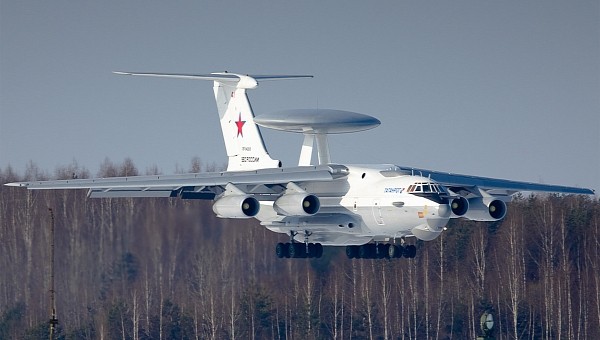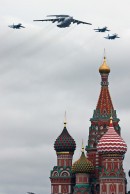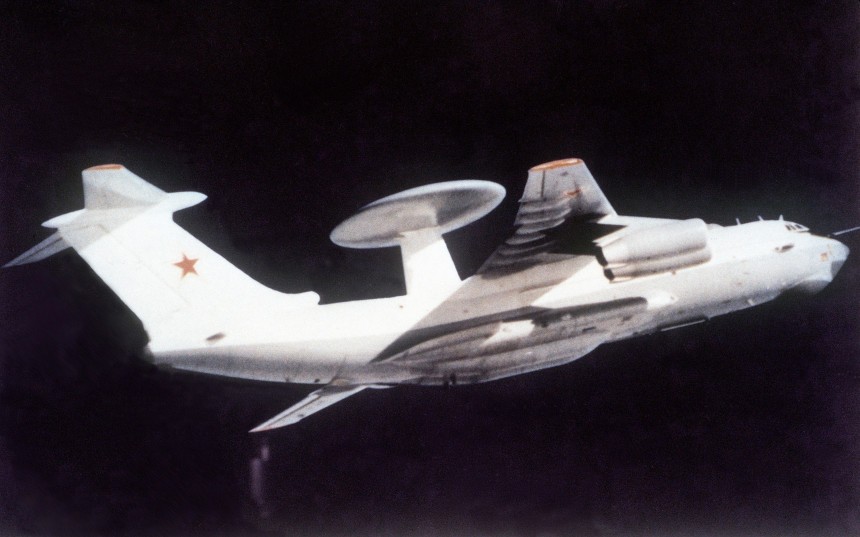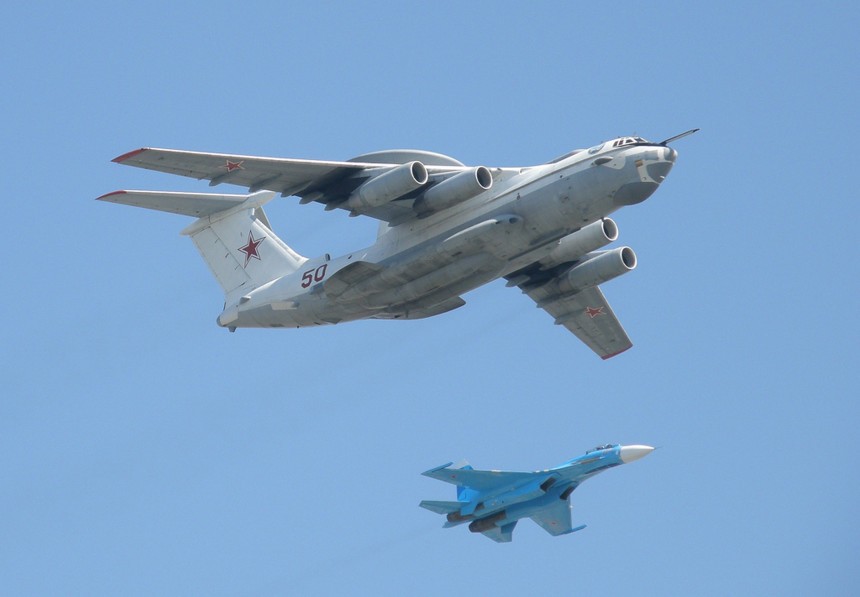Belarus may have been an afterthought in the west when it came to covering the Russian invasion of Ukraine. That was until some Belarusian partisans decided it was time to boogaloo. Their target? A Beriev A-50 airborne early warning and control jet that's reportedly worth £274 million each.
That's well north of $330 million in U.S. money. Not exactly a paltry sum when the rest of the Russian military appears to be held together by masking tape and weapons-grade propaganda. It costs a lot to maintain all that scrap, as it happens. The fact most Russian soldiers and pilots don't even want to be there doesn't help either.
That's because one of the two airplanes would not exist without the other. As the go-to strategic airlifter for both the Russians and the Ukrainians, the Il-76 knows many forms. First flown in 1971, the quad-engine jet dubbed "Candid" by NATO first flew in 1971 as the tentative replacement for the positively ancient Antonov An-12.
Because ex-Soviets still love their bureaucracy, deciphering all the Russian aviation bureaus can be challenging for a westerner. But in short, it's far more common for smaller Russian aerospace firms to manufacture copies of more popular domestic airframes from larger companies under license than in North America.
The long-standing working relationship between the Ilyushin and Beriev Design Bureau is a proof-positive of this uniquely ex-Soviet approach to the national aerospace sector. Best known for building admittedly neat-looking flying boats with either piston or jet engines, Beriev is nearly as old as Illyushin but nowhere near as recognizable outside of Russia.
The radar dome in question comes from the Moscow-based Vega Radio Engineering Corporation, notable for its cooperation with the Almaz-1 un-crewed reconnaissance satellite. Safe to say, there's not much one can do to avoid detection by one of these jets within its operating vicinity besides running the heck away. At least, that's what the Russians wished was the case.
The ability to track large targets like warships from up to 400 kilometers (250 mi) and between 60 to 150 targets simultaneously is undoubtedly impressive. Still, battles over Ukraine over the last year routinely prove that Russian early warning radar has its weaknesses. Powering the Beriev A-50 is a set of four Soloviev D-30KP low bypass turbofan engines jetting 117.68 kN (26,460 lbf) of thrust each.
That's good for a service ceiling of 12,000 m (39,000 ft) and a maximum range of 7,500 km (4,700 mi) while flying no faster than 900 km/h (560 mph). With dimensions of 49.59 m (162 ft 8 in) long, a 50.5 m (165 ft 8 in) wingspan, and a height of 14.76 m (48 ft 5 in), the A-50 is up there with the American C-17 Globemaster in terms of size.
The model is also utilized by the Chinese People's Liberation Army Air Force as the KJ-2000. Using a genuine IL-76 airframe as a base, Chinese components were added under the skin to create an all-new airplane. At least five such Chinese KJ-2000s are known to exist in 2023. Though perhaps not the most recognizable military plane of the war, shooting down Russian early-warning aircraft is a top priority of Ukraine's quest for air superiority in the homeland.
With that in mind, that brings us to a perfectly typical day in the City of Minsk, Belarus, on February 26th, 2023. As the country's dictator, Alexander Lukashenko, mulls deploying troops into Ukraine, Belarusian partisans hunted by the regime appear to have devised a cunning plan. Initial reports from the scene by Reuters and Al Jazeera indicate a Beriev A-50 came under attack from armed drones while on the ground at a military base near Minsk.
Alexander Lukashenko may be Vladimir Putin's greatest ally in the region. But that doesn't mean there are those in his country who see their involvement in the Ukrainian invasion as an outrage. Should separatist attacks like this one continue as the war drags on, expect what happens afterward to be nothing short of historic. As the acting President of Belarus since the far-off year of 1994, Lukashenko's had almost 30 years to mull over whether messing with Ukraine was worth it to him.
But if the statistics are anything to go by, there's reason to suspect this war will turn out just as bad for Belarus as it will for Russia if their involvement escalates. Whether that holds true or not remains to be seen.
Turning Belarus into a focal point
The Beriev A-50, believed to have been sabotaged and damaged by Belarusian separatist drones, is an interesting airplane in its own right. One with a history inseparably tied to another iconic ex-Soviet jet that's been the backbone of militaries in Eastern Europe since Brezhnev was still kicking around. Stylistically, there isn't all that much difference between the Ilyushin Il-76 and Beriev's A-50.That's because one of the two airplanes would not exist without the other. As the go-to strategic airlifter for both the Russians and the Ukrainians, the Il-76 knows many forms. First flown in 1971, the quad-engine jet dubbed "Candid" by NATO first flew in 1971 as the tentative replacement for the positively ancient Antonov An-12.
Because ex-Soviets still love their bureaucracy, deciphering all the Russian aviation bureaus can be challenging for a westerner. But in short, it's far more common for smaller Russian aerospace firms to manufacture copies of more popular domestic airframes from larger companies under license than in North America.
A large, lumbering Russian early warning jet
Beriev's made great use of Ilyushin's flagship military cargo platform over the years. With its first flight taking place in 1978, the Beriev A-50 entered service in 1985 and provided a fleet of 40 by 1992. Using similar technology to the American Boeing E-3 Sentry, the Beriev A-50's powerful radar dome can detect, identify, and coordinate counterattacks against an array of air, ground, and sea-fairing enemy targets.The radar dome in question comes from the Moscow-based Vega Radio Engineering Corporation, notable for its cooperation with the Almaz-1 un-crewed reconnaissance satellite. Safe to say, there's not much one can do to avoid detection by one of these jets within its operating vicinity besides running the heck away. At least, that's what the Russians wished was the case.
The ability to track large targets like warships from up to 400 kilometers (250 mi) and between 60 to 150 targets simultaneously is undoubtedly impressive. Still, battles over Ukraine over the last year routinely prove that Russian early warning radar has its weaknesses. Powering the Beriev A-50 is a set of four Soloviev D-30KP low bypass turbofan engines jetting 117.68 kN (26,460 lbf) of thrust each.
Ugly airframe, lots of lifting power
With a maximum takeoff weight of 170,000 kg (374,786 lb), there's plenty of room for the A-50's crew of at least 15 people to move around inside. Upgraded variants of the A-50 introduced trinkets like mid-air refueling functionality with the M variant and more electronics and creature comforts in the more modern A-50U. Around 40 A-50 airframes are known to be manufactured between 1978 and 1992.The model is also utilized by the Chinese People's Liberation Army Air Force as the KJ-2000. Using a genuine IL-76 airframe as a base, Chinese components were added under the skin to create an all-new airplane. At least five such Chinese KJ-2000s are known to exist in 2023. Though perhaps not the most recognizable military plane of the war, shooting down Russian early-warning aircraft is a top priority of Ukraine's quest for air superiority in the homeland.
With that in mind, that brings us to a perfectly typical day in the City of Minsk, Belarus, on February 26th, 2023. As the country's dictator, Alexander Lukashenko, mulls deploying troops into Ukraine, Belarusian partisans hunted by the regime appear to have devised a cunning plan. Initial reports from the scene by Reuters and Al Jazeera indicate a Beriev A-50 came under attack from armed drones while on the ground at a military base near Minsk.
Belarusian separatists strike
"They were drones (that carried out the attack). The participants of the operation are Belarusians," Aliaksandr Azarov declared. As the leader of the Belarusian anti-government organization BYPOL, Azarov's taken on the brunt of a brutally Soviet-style regime since long before the war in Ukraine began. With the one-year anniversary since the start of the invasion now behind us, it's anyone's guess what sort of role Belarus will play in the fiasco going forward.Alexander Lukashenko may be Vladimir Putin's greatest ally in the region. But that doesn't mean there are those in his country who see their involvement in the Ukrainian invasion as an outrage. Should separatist attacks like this one continue as the war drags on, expect what happens afterward to be nothing short of historic. As the acting President of Belarus since the far-off year of 1994, Lukashenko's had almost 30 years to mull over whether messing with Ukraine was worth it to him.
But if the statistics are anything to go by, there's reason to suspect this war will turn out just as bad for Belarus as it will for Russia if their involvement escalates. Whether that holds true or not remains to be seen.













